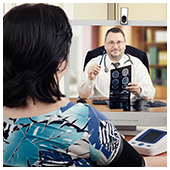Telemedicine to help transform healthcare

 Physicians in some parts of the world still make house calls, but they are becoming rare. Today, most patients either go to a clinic or hospital, make a quick trip to a pharmacy for instant relief, or get treatment at home via telemedicine. Although this medical practice might not sound familiar to some, it has been around for years.
Physicians in some parts of the world still make house calls, but they are becoming rare. Today, most patients either go to a clinic or hospital, make a quick trip to a pharmacy for instant relief, or get treatment at home via telemedicine. Although this medical practice might not sound familiar to some, it has been around for years.
Making telemedicine work
A key element in making telemedicine work is technology, which comprises of video-teleconferencing equipment, a fast and stable internet connection, and advanced telemedicine software. These elements are indispensable because this special type of medical practice requires highly visual interactions.
Healthcare businesses and individual medical practices with telemedical capability also need to comply with the regulations of the Health Insurance Portability and Accountability Act (HIPAA), the Health Information Technology for Economic and Clinical Health Act (HITECH), and other healthcare legislation. Mostly, these regulations involve compliance with the handling and storage of personally identifiable patient data.
To make telemedicine effective, healthcare providers need to exert as much effort in following the same rules as a traditional medical practice. But is it truly worth considering?
Benefits of telemedicine
- Easy access – Telemedicine solves the basic problem of access. For example, if a patient in a far-flung Nigerian town needs to see a US-based specialist, telemedicine can make that possible. In a less complicated medical situation, telemedicine solves the problems of mobility. Without having to go to the hospital for treatment, a patient can conveniently dial or log in to an online portal to consult a doctor.
- Efficiency – One of the more problematic aspects of a doctor’s visit is the long wait. Often, wait times take much longer than the actual consultation. Patients with minor illnesses would rather self-medicate than visit a hospital and suffer a long queue. With telemedicine, a patient can wait in the comfort of their own home.
- Better healthcare – Consulting your physician online doesn’t mean diminished quality of care — provided, of course, that all devices, telemedicine software, and other technical aspects work seamlessly. In some instances, remote medical care enhances the patient’s experience. Follow-ups, post-operation check-ups, and quick consultations can be done using a desktop computer, laptop, or smartphone, thereby reducing the possibility of missing an appointment.
- Lower healthcare costs – That’s not simply referring to the transportation expense of going to the doctor’s; the actual cost of an in-person visit is much higher than the cost of a virtual one. For minor ailments like colds and flu, a physical visit to the clinic might set you back as much as $100, whereas a virtual one only costs $45.
Telemedicine is not meant to take over conventional medical care, as the technology supplements it instead. Patients can expect an expansion of this practice among many medical providers, while healthcare providers can expect rapid growth in telemedicine technology, especially as healthcare compliance requirements evolve.
We stand at the forefront of technological innovations that will continue to define an industry as dynamic as healthcare. If you need industry-based knowledge, contact us today.
Subscribing to our
monthly newsletter
is your gateway to staying well-informed and up-to-date on the latest developments in the world of information technology and our upcoming events.
Browse Our Archives
BY YEAR:
BY TOPIC:

You must be logged in to post a comment.